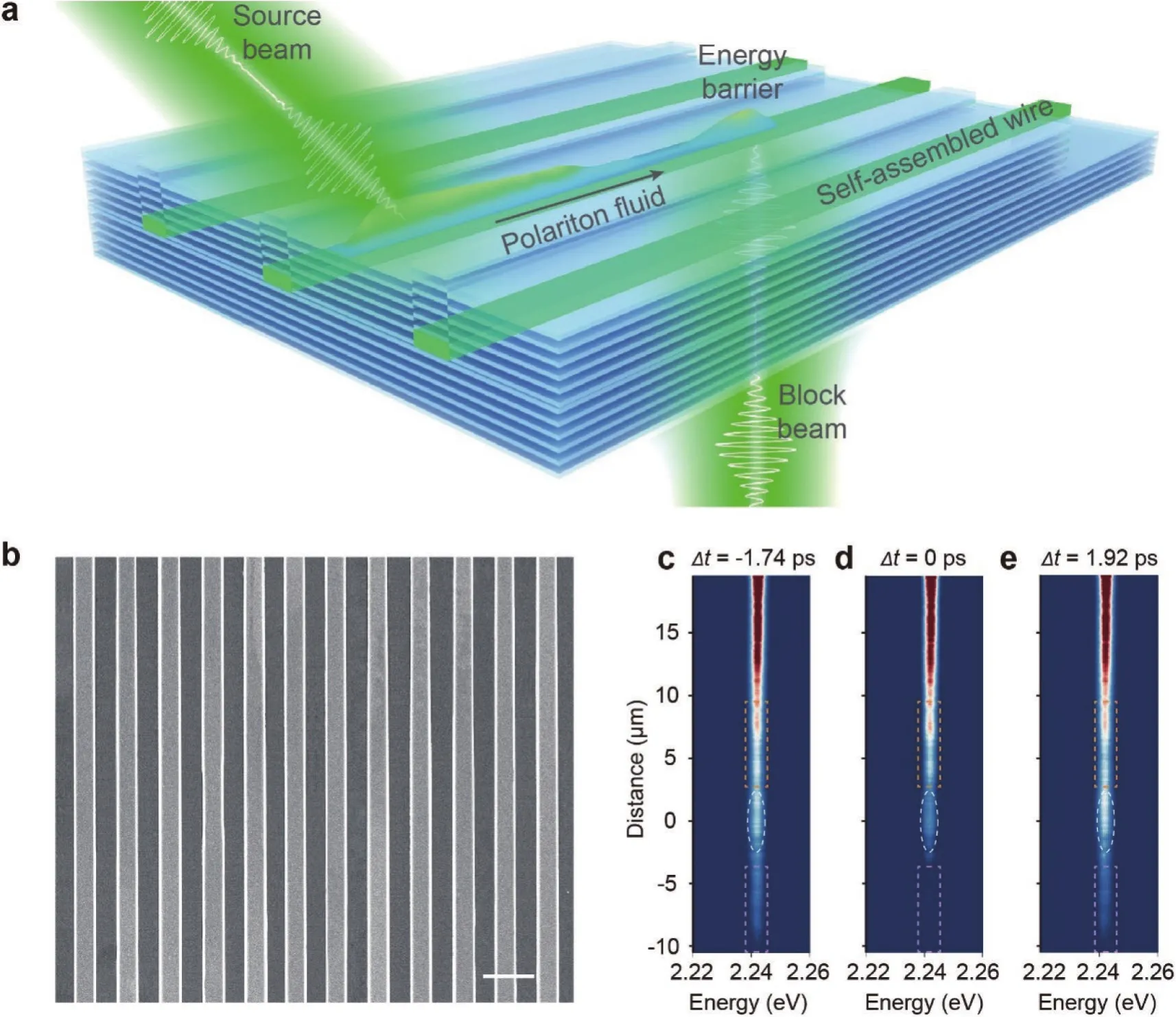All-optical switching based on self-assembled halide perovskite microwires
2022-02-15QingZhangandJunZhang
Qing Zhang and Jun Zhang
1School of Materials Science and Engineering, Peking University, Beijing 100871, China
2State Key Laboratory of Superlattices and Microstructures, Institute of Semiconductors, Chinese Academy of Sciences, Beijing 100083, China
3Center of Materials Science and Optoelectronics Engineering, University of Chinese Academy of Sciences, Beijing 100049, China
Optical switching is a fundamental element in all-optical integrated circuits and networks with ultrahigh speed and low energy consumption compared to their electronic counterparts.Switching on/off the waveguiding with another light beam demands large optical nonlinearity to compactify device footprint and decrease energy consumption, which is difficult to achieve in photonic systems.By introducing strong light-matter coupling in an optical cavity, all-optical switching has been realized in ultracold-atom gases[1], and cavity quantum electrodynamics of a single atom and a quantum dot[2,3], where giant optical nonlinearity stems from the matter part.Exciton polaritons, half-light, half-matter quasiparticles formed by strong coupling of excitons and photons in a semiconductor microcavity[4,5], represent a promising platform for all-optical logics and computations with considerable nonlinearity and on-chip integratability.
Writing inScience Advances(https://doi.org/10.1126/sciadv.abj6627), Fenget al.reports all-optical switching on the basis of exciton polaritons in self-assembled metal-halide perovskite microwire arrays[6].In this work, research group led by Prof.Qihua Xiong realized non-local and strongly interacting exciton polaritons in self-assembled halide perovskites at room temperature, which represents an important step towards on-chip integration of polaritonic devices.The concept of optical logics and circuits based on exciton polaritons was firstly proposed by Liewet al.in 2008[7].Then, experimental demonstration of polariton switching were realized in GaAs quantum wells by using spin-dependent polariton–polariton interactions[8], propagating polariton condensates[9], resonant tunneling of polaritons[10], phase-controlled interferometers[11]and polariton transistors[12].These polariton switches on the basis of GaAs quantum wells are restricted by their cryogenic operational temperature because of the small exciton binding energy.In 2019, polariton transistors were demonstrated by Lagoudakis and his colleagues in organic semiconductors at room temperature, but the localized exciton polaritons in organics restrict the on-chip integratability[13].From 2017, Xiong and his colleagues demonstrated exciton–polariton Bose–Einstein condensation[14], propagating polariton condensates[15], and polariton lattices[16,17]at room temperature in single-crystalline inorganic perovskites grown by chemical vapor deposition.Their recent work also showed that strong and robust optical nonlinearity exist in those devices[18].These works provide fundamental insights into exciton polaritons on the basis of perovskite materials.
The authors developed all-optical switching based on self-assembled CsPbBr3microwire arrays embedded in distributed Bragg reflector cavity.This optical switching is designed and fabricated based on three advantages.Firstly,single crystallinity of microwires suppresses the defect-induced localization and scattering of exciton polaritons and 1D morphology permits directional waveguiding of polariton fluids.Secondly, Wannier-Mott excitons with binding energy ofca.40 meV and Bohr radius ofca.3.5 nm in CsPbBr3underpin stable and delocalized exciton polaritons with strong interactions at room temperature.Thirdly, the developed self-assembly method provides a platform for direct patterning and integration of polaritonic devices.
The configuration of all-optical switching based on exciton polaritons is shown in Fig.1(a).This optical switching leverages propagating and interacting exciton polaritons in CsPbBr3microwires.The propagating polariton fluids with a defined momentum of 4.4μm–1is realized by an obliquely incident source beam, which is resonant with the lower polariton branch.To switch on/off the polariton propagation, the authors introduce localized polaritons with a zero momentum by a block beam.Because of strong polariton–polariton interactions, the polariton dispersion is blue-shifted in the block beam region, which can serve as an energy barrier to turn off the polariton propagation.The on/off of optical switching can be controlled by tuning the delay time of two beams.In such optical switch, the propagation length and interaction strength of exciton polaritons play important roles.The authors have determined a propagation length of around 25μm.This propagation distance benefits from the self-assembly method, which can fabricate microwires with single crystallinity and smooth surface to suppress the optical loss (Fig.1(b)).The exciton-exciton interaction coefficient has been determined as 4.1 ± 0.6μeV·μm2, which is comparable withca.6μeV·μm2in GaAs at cryogenic temperature.On the basis of strong interactions and delocalization of exciton polaritons, ultrafast all-optical switching with response time of less than 2 ps has been realized (Figs.1(c)–1(e)).This study employ waveguide exciton polaritons to construct all-optical switching at room temperature, which highlights its importance for onchip integration.

Fig.1.(Color online) (a) Scheme of all-optical switching based on interacting and propagating exciton polaritons in perovskite microwires.(b)Scanning electron microscopy image of CsPbBr3 microwire arrays.Scale bar, 10 μm.(c–e) Real-space PL spectra of optical switching at different delay time Δt.Figures are adapted from Ref.[6]with permission.Copyright 2021, American Association for the Advancement of Science.
For the practical applications of exciton polaritons in integrated photonics, future studies can be focused on following directions.First of all, the propagation length shown by Fenget al.is relatively short, which is restricted by the photon lifetime in microcavity.Improvement on the quality factor of microcavity is highly desired for the cascade of all-optical switching into logic gates and circuits for computation.Secondly,continuous-wave (CW) nonlinearity of exciton polaritons at room temperature will be another milestone for constructing polariton integrated circuits.In the present stage, polariton switching is developed based on femtosecond laser pump at room temperature.In striking contrast, GaAs quantum wells have demonstrated nonlinear optics effects and all-optical switching of exciton polaritons pumped by CW laser, albeit at cryogenic temperature.Thirdly, interfacing exciton polaritons in microcavity with silicon photonics platform is another intriguing direction for achieving integrated polaritonics.Even for high-QGaAs microcavity, the propagation length of polariton fluids is limited to several hundreds of micrometers, which cannot fulfill the requirement for onchip integration.Therefore, integration of photonic waveguides with polaritonic logical devices is promising for onchip applications of exciton polaritons.
杂志排行
Journal of Semiconductors的其它文章
- I nvestigation on the passivation, band alignment, gate charge,and mobility degradation of the Ge MOSFET with a GeOx /Al2O3 gate stack by ozone oxidation
- I nvestigation into the InAs/GaAs quantum dot material epitaxially grown on silicon for O band lasers
- High-operating-temperature MWIR photodetector based on a InAs/GaSb superlattice grown by MOCVD
- A 58-dBΩ 20-Gb/s inverter-based cascode transimpedance amplifier for optical communications
- Band gap tuning and p to n-type transition in Mn-doped CuO nanostructured thin films
- Vertical nanowire/nanosheet FETs with a horizontal channel for threshold voltage modulation
